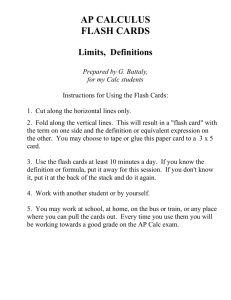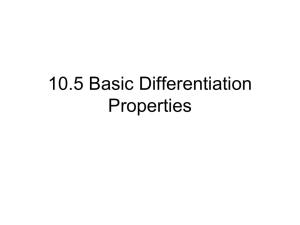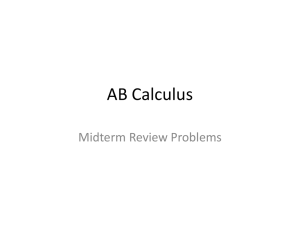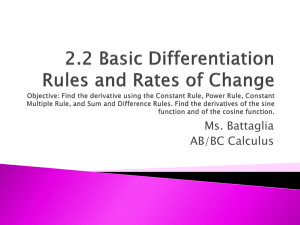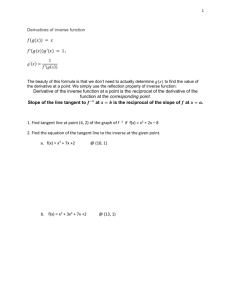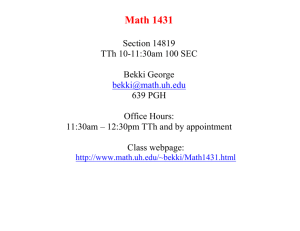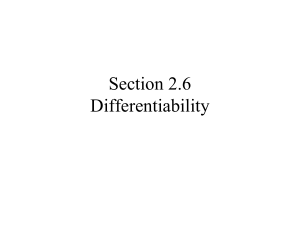cost function
advertisement
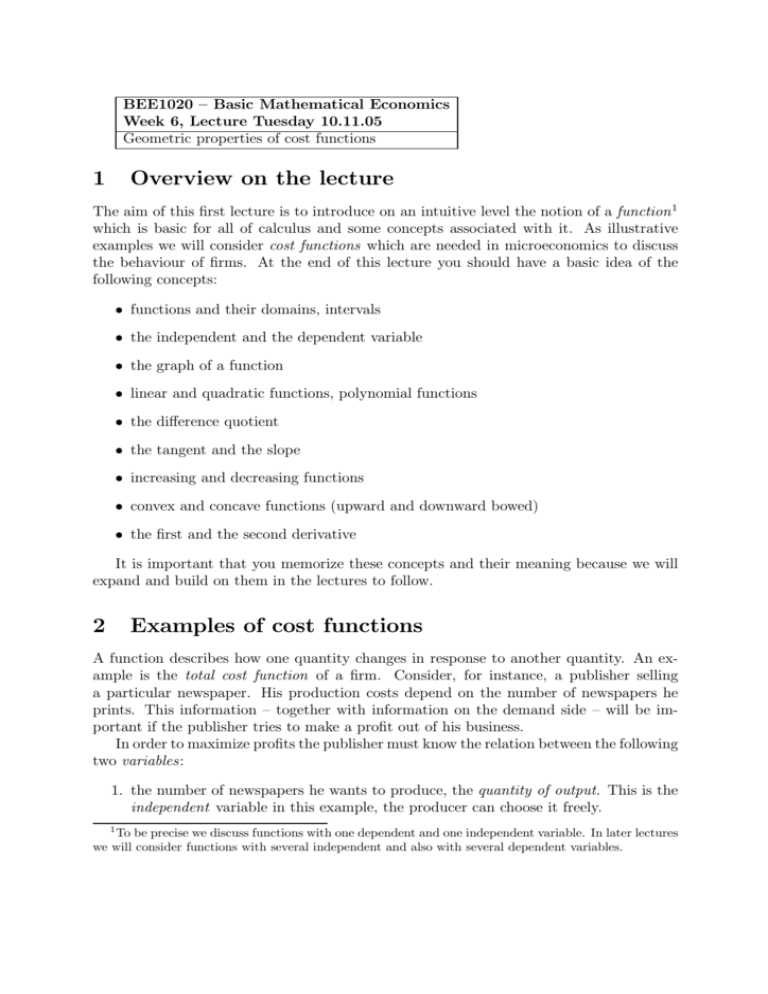
BEE1020 — Basic Mathematical Economics
Week 6, Lecture Tuesday 10.11.05
Geometric properties of cost functions
1
Overview on the lecture
The aim of this first lecture is to introduce on an intuitive level the notion of a function 1
which is basic for all of calculus and some concepts associated with it. As illustrative
examples we will consider cost functions which are needed in microeconomics to discuss
the behaviour of firms. At the end of this lecture you should have a basic idea of the
following concepts:
• functions and their domains, intervals
• the independent and the dependent variable
• the graph of a function
• linear and quadratic functions, polynomial functions
• the difference quotient
• the tangent and the slope
• increasing and decreasing functions
• convex and concave functions (upward and downward bowed)
• the first and the second derivative
It is important that you memorize these concepts and their meaning because we will
expand and build on them in the lectures to follow.
2
Examples of cost functions
A function describes how one quantity changes in response to another quantity. An example is the total cost function of a firm. Consider, for instance, a publisher selling
a particular newspaper. His production costs depend on the number of newspapers he
prints. This information — together with information on the demand side — will be important if the publisher tries to make a profit out of his business.
In order to maximize profits the publisher must know the relation between the following
two variables:
1. the number of newspapers he wants to produce, the quantity of output. This is the
independent variable in this example, the producer can choose it freely.
1
To be precise we discuss functions with one dependent and one independent variable. In later lectures
we will consider functions with several independent and also with several dependent variables.
2. the total costs of producing a given amount of newspapers. This is the dependent
variable in our example. It’s value depends on how many newspapers the publisher
decides to produce.
There are three ways to describe the relation between production costs and the number
of newspapers produced:
1. by a table,
2. by a graph,
3. using an algebraic expression to describe the relationship.
The first two ways appear natural, but it is the third, most compact, way of describing
the relationship on which we concentrate in this course. Here are three examples of types
of cost functions frequently used in microeconomics. The terminology used will become
clear during the lecture.
2.1
Example 1: Constant marginal costs
In tabular form:
quantity (in 100.000)
total costs (in 1000$)
0 1
2
3
4
5
6
90 110 130 150 170 190 210
7
230
With the aid of a graph:
220
200
180
160
140
120
TC
100
80
60
40
20
0
1
2
3
Q
4
5
6
7
In algebraic form:
T C (Q) = 90 + 20Q
2.2
Example 2: Increasing marginal costs
In tabular form:
quantity (in 100.000) 0
1
2
3
4
5
6
7
total costs (in 1000$) 110 135 170 215 270 335 410 495
2
With the aid of a graph:
500
400
300
TC
200
100
0
1
2
3
Q
4
5
6
7
In algebraic form:
T C (Q) = 5Q2 + 20Q + 110
2.3
Example 3: U-shaped marginal costs
In tabular form:
quantity (in 100.000) 0 1 2
3
4
5
6
7
total costs (in 1000$) 50 94 114 122 130 150 194 274
With the aid of a graph:
240
220
200
180
160
140
TC
120
100
80
60
40
20
0
1
2
3 Q
4
5
6
7
In algebraic form:
T C (Q) = 2Q3 − 18Q2 + 60Q + 50
3
3.1
Functions
Concept and Notation
A function is a rule which specifies for each object in a set A exactly one object in a the
set B. The set A is called the domain and the set B the co-domain.
3
In this course A and B are mostly subsets of the number line. For a costs function
domain and co-domain are the set of non-negative numbers because neither quantities
nor costs can be negative numbers. It is important to understand that a function is
never completely described just by a formula like y = f (x) = x2 + 1. One has to name
the domain and co-domain as well. However, what is the domain or co-domain is often
implicitly clear and hence not mentioned.
Three types of notations are common to denote functions:
a) The inventors of calculus — Isaac Newton (1643 — 1727) and Gottfried Wilhelm
Leibniz (1646 — 1716) — used the notation y (x) where y is called the dependent variable
and x the independent variable. For instance, let
y (x) = x2 + 1.
Then the value of the variable y depends on the value of the variable x according to the
formula on the right, so for x = 1 we have y = 2, for x = 3 we have y = 10 and so
on, which can also be written as y (1) = 2 and y (3) = 10. We used this notation above
to describe the costs functions: The dependent variable T C denoted total costs and the
independent variable Q the quantity produced.
b) Slightly more modern and more explicit is the notation
y = f (x) = x2 + 1.
Again, y and x denote the dependent and independent variable and hence represent
numbers. The letter f does, however, not represent a number, but a relationship described
by a formula.
2
+ 1
y=x
f (x)
This is the most frequently used notation which we will also adapt.
As mentioned, a function is only completely specified if besides the rule its domain and
co-domain are fixed. The above notations require us to deduce domain and co-domain
from the context. For instance, when
√
y (x) = x − 1
the domain has to be the set of all numbers bigger or equal to 1 because negative numbers
have no roots. As a second example, the function
y (x) = 2x3 − 18x2 + 60x + 50
is defined for all numbers, so we should take the whole number line as the domain and
the co-domain of the function. However, when we write
T C (Q) = 2Q3 − 18Q2 + 60Q + 50
and deal with total cost functions it is implicit that the domain and the range are the
sets of all non-negative numbers.
4
c) Most modern, and designed for those who demand complete rigour, is the notation
f : A −→ B
x −→ f (x)
where f is the name of the function, A is the domain and B the co-domain. For instance
f : {x ≥ 1} −→ {y
√ ≥ 0}
x
−→
x−1
specifies the rule, the domain and the co-domain. (Here the curly brackets indicate a set.
So {x ≥ 1} is the set of all numbers not smaller than one.) We will not use this notation.
3.2
Graphs of functions
The graph of a function y = f (x) is the curve consisting of all points (x, y) = (x, f (x))
drawn in coordinate system with x on the horizontal and y on the vertical axis where x
varies over the domain of the function.
Graphs quickly reveal information which is not obvious from a table of the algebraic
description of a function.
A curve or merely a collection of dots?
The Vertical Line Test: A curve is the graph of a function if and only if no vertical
line intersects the curve more than once.
3.2.1
Inverse functions
To illustrate the vertical line test, consider what happens to the graph of the function if
we invert the graph in the sense that we interchange the horizontal and the vertical axis.
A point (x, y) then becomes the point (y, x), for instance (−2, 4) becomes (4, −2). As the
5
result, the graph is mirrored at the 45◦ -line.
y
5
4
3.75
2
2.5
-4
-2
0
2
4
-2
1.25
-4
0
0
1.25
2.5
3.75
5
x
Inverting a graph.
square and square root
The U-shaped curve in this figure on the left is the graph of the square function y = x2 .
The mirrored C-shaped curve is not the graph of a function because it fails the vertical
√
line test. This is so because every positive number y ≥ 0 has two roots ± y, for instance
the roots of y = 4 are x = ±2. Hence the points (−2, 4) and (2, 4) are both on the
U-shaped curve and so (4, −2) and (4, 2) are on the C-shaped curve which hence violates
the vertical line test. If we restrict the function y = x2 to the positive numbers, as on
√
the right, we have an invertible function. Its inverse is x = y, the√square root function.
√
Notice that the root symbol y refers only to the positive root. 4 = −2 is incorrect,
while (−2)2 = 4 is correct.
When we invert the graph of the cost function in Example 3 above the vertical line
test shows that we obtain again a graph of a function which we call the inverse of the
original function.2
240
220
200
180
160
140
TC
120
100
80
60
40
20
7
6
5
4
Q
3
2
1
0
1
2
3 Q
4
5
6
0
7
The graph from Example 3.
50
100
TC
150
200
250
The inverted graph from Example 3.
2
The fact that the function has an inverse does not mean that it is easy to give an algebraic description
of the inverse. In the example one has to solve cubic equations. The inverse function turns out to be
13 Q (T C) =
−244 + 2T C + 2 (14 900 − 244T C + T C 2 )
2
2
− +3
3
−244 + 2T C + 2 (14 900 − 244T C + T C 2 )
6
In contrast, the inverted graph of the function
T C (Q) = 2Q3 − 18Q2 + 48Q + 86
is not the graph of a function:
250
7
6
200
5
150
4
TC
Q
3
100
2
50
1
0
1
2
3
Q
4
5
6
0
7
50
The graph of the function TC(Q).
3.3
100
TC
150
200
250
The inverted graph.
Continuous and differentiable functions
Calculus is the method to study differentiable functions. Therefore we will primarily deal
with functions of this type. All differentiable functions are continuous. Roughly speaking,
a function is continuous if its graph can be drawn in a single stroke, without ever lifting
the pen. There should be no “jumps”. This must at least hold over all intervals where
the function is defined. An interval is a part of the number line with no “holes” in it. All
examples of functions above were continuous. The function y = f (x) = x1
4
2
-4
-2
0
2
x
4
-2
-4
is an example of a function with a ‘hole’ in the domain because x1 is defined for all numbers
except zero.3 y = x1 is a continuous function because you can draw the graph in one stroke
for the negative and for the positive numbers.
An example of a function which is not continuous at x = 0 is the sign function defined
by
+1 for x > 0
sign (x) =
0 for x = 0
−1 for x < 0
3
See the appendix of (?) for a detailed explanation of the term.
7
which has the graph
)
1
0.8
0.6
0.4
0.2
-4
-2
0
-0.2
2 x
4
-0.4
-0.6
-0.8
-1
(
An important property of continuous functions is known as the theorem of Bolzano: Suppose that the function y = f (x) is defined and continuous on the interval a ≤ x ≤ b and
that f (a) < 0 and f (b) > 0. Then there exists a root between a and b, i.e., a number c
with a < c < b and f (c) = 0. (The intermediate value theorem discussed in (?), Chapter
1, is a generalization of this theorem.)
c
a-4
0.5
2 x
-2
0
4
b
-0.5
-1
-1.5
-2
-2.5
(1)
Intuitively, a function is differentiable if its graph has no kinks. A function with a
kink (or cornerpoint) at x = 0 is the absolute value function
x for x > 0
0 for x = 0
|x| =
= x · sign (x)
−x for x < 0
which has the graph
5
4
2
1
-4
-2
0
2 x
4
-1
-2
.
8
At a kink the graph can have several tangents, i.e., several lines which touch the graph
in this point.
5
4
2
1
-4
-2
0
2 x
4
-1
-2
For a function to be differentiable there has to be a unique tangent at each point of the
graph.4
240
220
200
180
160
140
TC
120
100
80
60
40
20
0
1
2
3 Q
4
5
6
7
Tangents for the graph from Example 3.
To summarize, a curve is the graph of a function if it passes the vertical line test. The
function is continuous if its graph can be drawn in one stroke and it is differentiable if the
graph has no kinks.
4
Fixed costs and variable costs
Returning to our three leading examples we notice first that all graphs intersect the
vertical axis at a positive level, for instance T C (0) = 50 in the third example. The value
of the cost function at zero gives the set-up costs or fixed costs of running the enterprise
which do not depend on the number of newspapers actually printed. For instance, in
order to guarantee a certain quality of the newspaper the publisher has to hire a number
of journalists regardless of how many copies are sold. In contrast, the variable part of
costs are paper and ink etc. which increase with output. One defines the fixed costs as
F C = T C (0)
4
In addition we need that the tangents are not vertical lines, so that their slopes are not infinite.
9
and the variable cost function as
V C (Q) = T C (Q) − F C
In Example 3 one has
F C = 50
V C (Q) = 2Q3 − 18Q2 + 60Q
250
250
200
200
150
150
FC
VC
100
100
50
50
0
1
2
3 Q
4
5
6
0
7
The fixed costs.
5
1
2
3 Q
4
5
6
7
The variable costs.
Costs are positive and increasing
Obviously, costs are always positive numbers. The graphs show that all cost functions
considered above are positively-valued.
It is also intuitive that cost functions should be increasing functions in the sense that
higher output means higher costs: Q1 < Q2 implies T C (Q1 ) < T C (Q2 ). At least they
should be non-decreasing in the sense that Q1 < Q2 implies T C (Q1 ) ≤ T C (Q2 ).
We see immediately from the graphs which move upward from left to right that this
is the case in our examples. We also see it from the tables. However, how can we deduce
directly from the algebraic description of a cost function that it is positive and increasing?
Here the main problem is to show that a function is increasing because by the definition
of an increasing function:
Theorem 1 Suppose a given function T C (Q) has non-negative fixed costs T C (0) and is
increasing. Then the costs T C (Q) are positive for all Q > 0.
6
Linear functions
The total cost function in Example 1 is an example of a linear function, i.e., a function
who’s graph is a (non-vertical) straight line. Let us look at the cost increases ∆T C in
this example (we use the greek letter “capital delta” to indicate differences).
Q
0
1
2
3
4
5
6
7
TC
90 110 130 150 170 190 210 230
∆T C
20 20 20 20 20 20 20
10
We see that the cost increases are constant, regardless of how many newspapers are
currently printed, it costs $2,000 more to print 100,000 newspapers more.
That we have a linear cost function is less obvious when the output levels in the table
are not equidistant:
Q
0
3
4
7
11 12 17 20
TC
90 150 170 230 310 330 390 490
∆T C
60 20 60 80 20 100 60
In this case we have to look at the rates of change or the difference quotients
∆T C
T C (Q1 ) − T C (Q0 )
=
∆Q
Q1 − Q0
where Q0 and Q1 are distinct quantities:
Q
0
3
4
7
11 12 17
20
∆Q
3
1
3
4
1
5
3
TC 90 150 170 230 310 330 430 490
∆T C
60 20 60 80 20 100 60
∆T C
20 20 20 20 20 20 20
∆Q
The main characteristic of a linear function is that the rate of change is the same, whatever
two quantities Q0 and Q1 we compare. This rate is called the slope or gradient of the
line. Economists speak of constant marginal costs: The cost of producing one more unit
of output is always the same, regardless of what is already produced. In our example the
marginal costs are
∆T C
$1, 000
= 20 ×
= 20 (×1p)
∆Q
100, 000
so, printing an additional newspaper always costs 20p more. Consequently, printing 100
newspapers more costs $20 more etc.
Generally, for a linear function it is easy to decide whether it is increasing or not:
Theorem 2 A linear function is increasing if and only if its slope is positive.
Recall from geometry that there is a unique line passing through two distinct points.
Correspondingly, we can deduce all there is to know about a linear cost function once we
know the total costs at just two distinct quantities Q0 and Q1 :
1. We can calculate the marginal costs as the ratio between the induced change in
costs and the change in the quantity produced
m=
∆T C
T C (Q1 ) − T C (Q0 )
=
∆Q
Q1 − Q0
2. Because the rate of the change is the same, regardless of which two quantities we
use to calculate it, we have for a fixed quantity Q0 and any other quantity Q
T C (Q) − T C (Q0 )
=m
Q − Q0
11
or
T C (Q) = T C (Q0 ) + m (Q − Q0 ) .
We can now calculate total costs for any quantity. In general, this description of a
linear function is called the point-slope form.
3. In particular, we can calculate the fixed costs as
F C = T C (0) = T C (Q0 ) − mQ0 .
For any quantity Q we obtain
T C (Q) = T C (Q0 ) − mQ0 + mQ = F C + mQ
which is called the slope-intercept form of a linear function.5 The variable costs are
simply
V C (Q) = mQ.
Exercise 1 The total costs are $1600 for producing 300 CDs and $2000 for producing
500 CDs. Assuming a linear cost function, determine the marginal costs and the fixed
costs.
7
Non-linear cost functions
Also the cost functions in Example 2 and 3 are increasing. Correspondingly, the cost
increases ∆T C are always positive in Example 2 and 3, as shown in the following tables.
Example 2:
Q
TC
∆T C
0
110
Q
TC
∆T C
0
50
1
2
3
4
5
6
7
135 170 215 270 335 410 495
25
35
45
55
65
75
85
Example 3:
1
94
44
2
114
20
3
122
8
4
5
6
7
130 150 194 274
8
20
44
80
However, the cost increases are no longer constant because the cost functions are no longer
C
linear. Similarly, the rates of change ∆T
are no longer constant.
∆Q
To deal with such cases one uses tangents to approximate the graph near a point. The
rates of change can then be approximated by the slope of a tangent, at least for small
changes of the quantity produced. The following graph indicates that the tangent at
5
Because the marginal cost m is the slope of the line and the fixed costs F C give the intercept of the
line with the vertical axis.
12
(3, T C (3)) = (3, 215) is indeed a pretty good approximation of the correct cost function
in Example 2 for quantities between 2 (×100.000) and 4 (×100.000):
260
240
220
200
180
2
2.2
2.4
2.6
2.8
3
Q
3.2
3.4
3.6
3.8
4
(2)
With the methods introduced below the equation for the tangent is calculated as:
t (Q) = 215 + 50 (Q − 3)
where 50(×1p) is the slope of the tangent. So the cost of an additional newspaper is
roughly 50p more, additional 1,000 copies cost roughly $50 more etc. In economics the
slope of the tangent 50(×1p) is called the marginal costs because it is approximately the
cost of producing a ‘small ’ unit more. In our example the exact cost of producing an
additional newspaper is
(T C (3.000, 01) − T C (3)) × ($1000) = (215.0005000005 − 215) × ($1000)
= 0.0005000005 × ($1000) = 50.0005p
7.1
The first derivative
The gradient of a function y = f (x) at a value x0 of the independent variable is the slope
of the tangent to the graph of f (x) at the point (x0 , f (x0 )) . It is written as y (x0 ) or
dy
dy
df
f (x0 ) (Newton) or as dx
(x0 ) or as dx
or as dx
(x0 ) (the differential quotient, Leibniz).
|x0
Consequently, the tangent is the graph of the linear function
t (x) = f (x0 ) + f (x0 ) (x − x0 )
in point-slope form.
The new function which assigns to each value of the independent variable x the slope
of the corresponding tangent is called the (first) derivative of y = f (x).6 It is denoted
df
dy
by f (x) (Newton) or dx
or dx
(Leibniz). The method to calculate derivatives is called
differentiation.
6
Because it is a new function derived from the old function y (x).
13
7.2
Polynomials
A polynomial of degree n is a function of the form
f (x) = an xn + an−1 xn−1 + . . . + a2 x2 + a1 x1 + a0 x0
= an xn + an−1 xn−1 + . . . + a2 x2 + a1 x + a0
with constants an , an−1 , · · · , a0 where the leading coefficient an is not zero. an xn is called
the leading term and a0 the constant term. Roughly speaking, a polynomial is a sum
of powers xk of the independent variable which are called monomials (mono = single,
poly = many). Special cases are the constant functions f (x) = a0 , the linear functions
f (x) = a1 x + a0 , the quadratic functions f (x) = a2 x2 + a1 x + a0 and the cubic functions
y (x) = a3 x3 + a2 x2 + a1 x + a0 .7
The derivative of a power function y = xk is
y = kxk−1
The derivative of a polynomial function f (x) is
f (x) = nan xn−1 + (n − 1) an−1 xn−2 + . . . + 2a2 x2−1 + a1 x1−1 + 0a0 x0−1
= nan xn−1 + (n − 1) an−1 xn−2 + . . . + 2a2 x1 + a1 + 0
In particular, the derivative of a cubic function is quadratic, the derivative of a quadratic
function is linear, the derivative of a linear function a1 x + a0 is constant (because the
slope is constant) and the derivative of a constant function is zero.
7.3
Marginal costs in Examples 2 and 3
Notice first that for the linear total costs function T C (Q) = 90 + 20Q that the marginal
C
= 20 in accordance with the above rule for differentiating.
costs are indeed M C (Q) = dT
dQ
We can now calculate the marginal cost function in Example 2 as:
T C (Q) = 5Q2 + 20Q1 + 110
dT C
M C (Q) =
= 2 × 5Q1 + 20Q0 = 10Q + 20
dQ
In particular, M C (3) = 30 + 20 = 50, as claimed above. In Example 3:
T C (Q) = 2Q3 − 18Q2 + 60Q + 50
dT C
M C (Q) =
= 3 × 2Q2 − 2 × 18Q + 60 = 6Q2 − 36Q + 60
dQ
The following tables compare the cost increases from the above tables with the marginal
costs. Example 2:
Q
TC
∆T C
MC
7
0
110
1
135
25
20
2
170
35
30
3
215
45
40
4
270
55
50
5
335
65
60
6
410
75
70
7
495
85
80
The constant function y (x) = 0 is considered as a polynomial “of degree −∞”.
14
90
Example 3:
Q
TC
∆T C
MC
7.4
0
50
1
94
44
60
2
114
20
30
3
122
8
12
4
130
8
4
5
150
20
12
6
194
44
30
7
274
80
60
102
Increasing functions and upward-slopedness
We can now give a very simple algebraic argument to show that the cost function T C (Q)
in Example 2 is upward-sloped for positive Q in the sense that all tangents have positive
slope: Namely, the marginal costs MC (Q) = 10Q + 20 are always bigger than 20 and
hence positive.8
Geometrically, the following conjecture now suggests itself:
Conjecture 1 A function is increasing if and only if all its tangents are upward-sloped,
i.e., have positive slope.
It turns out that this conjecture is ‘almost’ correct. However, the following two qualifications have to be made:
a) In the following example all tangents to the graph have positive slope, but the
function is not increasing.
10
8
6
4
2
-3
-2
-1
0
-2
1
x
2
3
-4
-6
-8
-10
Upward-sloped, but not increasing.
However, if we restrict attention to one of the intervals x < −1, −1 < x < 1 or 1 < x,
our conjecture holds.
8
An algebraic argument for Example 3 is more tricky, involving the infamous “quadratic extension”:
MC (Q) = 6 Q2 − 6Q + 10 = 6 Q2 − 6Q + 9 + 1
= 6((Q − 3)2 + 1)
≥0
For any Q we know that (Q − 3)2 is non-negative, hence (Q − 3)2 + 1 and 6 (Q − 3)2 + 1 are positive
numbers.
15
b) In the following example the tangent to the graph at (0, 1) is horizontal, i.e., it has
slope zero. Nonetheless, the function is strictly increasing:
4
3
1
-1.5
-1
-0.5
0
0.5
x
1
1.5
-1
-2
Increasing with a horizontal tangent.
If the derivative is occasionally zero but otherwise positive, the function is still increasing.
Generally, the following can be shown:
Theorem 3 A continuously differentiable function9 is increasing on an interval if and
only if its first derivative is non-negative in the interval and not constantly zero on any
subinterval.
Theorem 4 A continuously differentiable function10 is decreasing on an interval if and
only if its first derivative is non-positive in the interval and not constantly zero on any
subinterval.
The following example of a non-decreasing, but not increasing function is ruled out
by the conditions of the theorem:
1.1
1.05
1
0.95
0.9
-0.4 -0.2
0
0.2
0.4
0.6
x0.8
1
1.2
1.4
Non-decreasing, but not increasing.
Notice that a horizontal line never intersects the graph of function twice if and only if the
function in increasing or decreasing. Therefore the vertical line test yields:
9
“continuously differentiable” means that the first derivative exists and is a continuous functions.
“continuously twice differentiable” means that the first and the second derivative exist and are continuous functions.
10
16
Theorem 5 A function is invertible if and only if it is increasing or decreasing.
Summary: The first derivative measures how steeply a function increases. Increasing
functions have positive derivatives, decreasing functions have negative derivatives.
17


